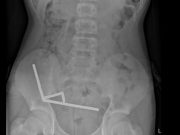Tag: Emergencies / First Aid
Distance to Primary Care Impacts Nonurgent ED Use, Cancer Screening
Patients living more than 30 km from family doctor have increased odds of having no visits with any family physician in previous two years
Standardized Discharge Framework Improves Discharge Efficiency
Findings seen for patients with four common diagnoses during an 18-month quality improvement study
Companion Chatbots Have Fewer Safeguards for Teens Than General-Assistant Chatbots
Findings seen for prompts related to adolescent health emergencies
AEDs in Houses Improve Outcomes for Cardiac Arrest With Shockable Rhythm
Incremental cost-effectiveness ratio was $4,481,659 per quality-adjusted life-year for AED in a private home
Guidance Updated for CPR and Emergency Cardiovascular Care
Specific recommendations made for adult, pediatric, neonatal life support; resuscitation education; systems of care
Teen Loses Part of Bowel After Swallowing 80+ Magnets
Once inside his digestive tract, the magnets pulled sections of his bowel toward each other, causing severe internal damage
AI May Help Predict Which Kids Seen in ED Will Develop Sepsis
Models based on routine electronic health record data
Majority of Patients in ED With Sickle Cell Crisis Not Triaged Appropriately
65.2 percent of patients with sickle cell disease with vaso-occlusive crisis assigned to emergency severity index 3
Intranasal Adrenaline Offers Viable, Needle-Free Option for Anaphylaxis
Intranasal adrenaline demonstrated comparable or faster absorption compared with intramuscular treatment
Experience at Radiology Department Described After Mass Casualty Event
Enhanced staffing and flexible resource allocation were key in managing patient surge after Oct. 7, 2023, attack in Southern Israel














